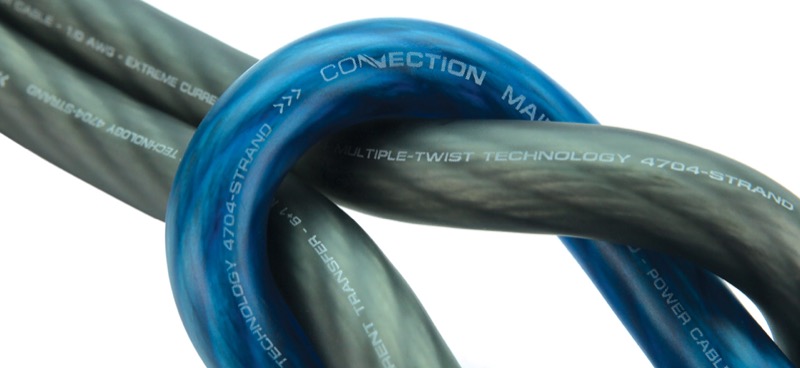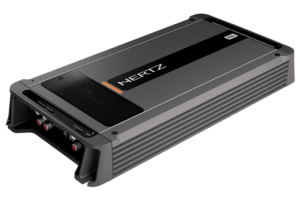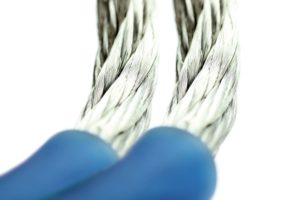 Clients purchasing a car audio amplifier from Mobile Edge in Lehighton often don’t understand the importance of using quality power wire. Before we dive into a discussion about the solutions we use, it’s crucial to know that no amplifier can produce power to your speakers or subwoofers unless it can draw power from the battery. The wire we use in your installation needs to be sized appropriately, of the proper construction and installed correctly.
Clients purchasing a car audio amplifier from Mobile Edge in Lehighton often don’t understand the importance of using quality power wire. Before we dive into a discussion about the solutions we use, it’s crucial to know that no amplifier can produce power to your speakers or subwoofers unless it can draw power from the battery. The wire we use in your installation needs to be sized appropriately, of the proper construction and installed correctly.
Car Audio Amplifier Power Wire Size
 Given that our cars’ and trucks’ electrical systems only produce about 13.5 volts (as compared to 120 volts in our homes), our amplifiers need to draw a lot of current to reproduce music at high volume levels.
Given that our cars’ and trucks’ electrical systems only produce about 13.5 volts (as compared to 120 volts in our homes), our amplifiers need to draw a lot of current to reproduce music at high volume levels.
The size of the wire we use in an installation determines how much of the voltage at the battery can be delivered to the amplifier. If the wire isn’t big enough, there’s too much resistance, and that results in a voltage drop across the wire. For example, let’s say you’ve purchased a Hertz ML Power 1 amplifier to drive a pair of 12-inch subwoofers. This amp can produce 1,000 watts of power. As such, the amp may need to draw as much as 92.6 amps of current. If we run a high-quality four-AWG conductor to the battery, this draw of 92.6 amps will result in a voltage drop of 0.38 volt in the wire itself. Our amp will see about 13.1 volts instead of the 13.5 that’s at the battery and alternator. Don’t fret: This behavior is absolutely normal.
What if someone (other than us) were to use a low-quality wire to connect this same amplifier to the battery? Perhaps they found a deal on some inexpensive four-gauge cable that uses some aluminum instead of just copper in its construction. We’ve seen tests where wire that is undersized and constructed with a significant amount of aluminum has four times the resistance of a proper copper conductor. These low-quality, high-resistance cables can increase the drop to 1 volt or more. The amp would need to draw almost 100 amps of current to make the same power. Most amplifiers produce less power when they have less voltage to work with. In short, this person would be throwing away performance.
Choosing the Right Power Cable
 We use the Connection brand of power and ground wire and their fuse holders here at Mobile Edge. The wire meets the size requirements to use the American Wire Gauge (AWG) label, and it’s constructed with corrosion-resistant tinned copper strands. There’s no aluminum in these wires.
We use the Connection brand of power and ground wire and their fuse holders here at Mobile Edge. The wire meets the size requirements to use the American Wire Gauge (AWG) label, and it’s constructed with corrosion-resistant tinned copper strands. There’s no aluminum in these wires.
We also use ANL and Mini-ANL fuse holders at the battery to ensure a solid and reliable connection while providing proper over-current protection. Proper fusing is essential should the vehicle ever get into an accident.
What To Look For When Shopping for Power Wire
We know that high-quality power wire isn’t cheap. The price of copper has tripled in the last 20 years. While some of the options seem tempting, you are risking not being able to extract all the performance possible from your amplifier. If you see a wire labeled as 4-gauge instead of 4-AWG, there’s a good chance it’s undersized. If there’s no mention of oxygen-free copper (OFC) or on that package, it may be copper-clad aluminum (CCA) or contain some other metal with less conductivity.
We don’t take chances with the performance and reliability of the products we install. We use high-quality wiring and industry best practices to ensure reliability and optimize performance. If you are looking for a reliable, high-performance audio system upgrade for your car or truck, drop by Mobile Edge in Lehighton and talk to one of our Product Specialists. If you can’t visit the store, give us a call or send our team an e-mail by clicking on the red button below.
